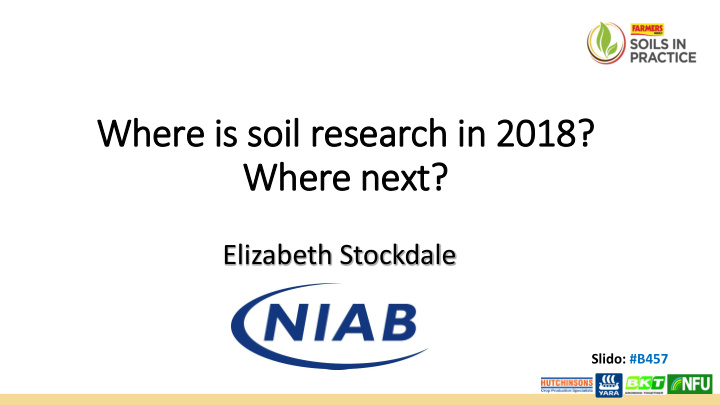



Where is is soil research in in 2018? Where next? Elizabeth Stockdale Slido: #B457
Biological Chemical Physical Slido: #B457
Food web interactions Earthworms Protozoa Bacteria Bacterial feeding nematodes Plant Predatory residues nematodes Collembola comminution Enchytraeids Soil organic matter Fungi Fungal feeding nematodes Predatory Fungal feeding mites mites Slido: #B457
Slido: #B457
Studies of impacts on processes • Decomposition of organic matter • Transformation of chemicals between forms • Pesticide degradation • Degradation of pollutants • Association with plants ( Rhizobia , mycorrhizae) • Plant disease • Biological control of plant pathogens • Production of hydrophobic waxy compounds • Formation and stabilisation of soil structure Slido: #B457
Slido: #B457
SOIL LIFE • There is lots of it • Very species rich – still more to find and identify • Hangs out in hot spots • High proportion dormancy • Specialists – but lots of shared roles Slido: #B457
Genes now key to identification in soils, just as in crime drama… Slido: #B457
The microbial biomass concept Substrate utilisation, PLFAs Detailed studies of the functional diversity of whole population Plant and animal residues CO 2 Extraction and culturing Detailed studies of a small part of the population Inorganic N,P,S etc. microbial and genetic diversity Direct Soil observation organic Total numbers but Microbial biomass matter no understanding Whole nutrient pool, of functional roles. improved understanding of function, reduced resolution. DNA and molecular methods Slido: #B457 Detailed studies of genetic composition of whole population
Broadbalk FYM/N N144 NO Slido: #B457
Experimental Design 3 Samplings: 3 Plots: • Before NH 4 NO 3 application • No Nitrogen • 3 days after NH 4 NO 3 application • 144 kg N ha -1 as NH 4 NO 3 in spring • 6 weeks after NH 4 NO 3 application • 48 kg N ha -1 as NH 4 NO 3 in spring 35 t ha -1 Manure in autumn • Pre-manuring • Post-manuring Slido: #B457
Ammonium concentrations in soil 80 70 60 mg N kg soil -1 50 NO 40 N144 FYM/N 30 20 10 0 Pre-N 3d Post-N 6w Post-N Pre-Man Post-Man Slido: #B457
15 15 N to determine rates of nit itrif ification Supply of soil 14 N 15 N Slido: #B457 Time
Nitrification Rates 9 Rate of nitrification (mg N kg -1 d -1 ) 8 7 6 NO 5 N144 FYM/N 4 3 2 1 0 Slido: #B457 Pre-N 3d Post-N 6w Post-N Pre-Man Post-Man
Number of amo genes as determined by cPCR 8 7 Copies of amo gene g soil -1 6 5 4 3 2 1 0 FYM/N FYM/N FYM/N FYM/N FYM/N N0 N0 N0 N0 N0 N144 N144 N144 N144 N144 Slido: #B457 Pre-Man Post-Man Pre-N 3d Post-N 6w Post-N
So what was learned about impacts of N fertilisation … • Nitrification responds rapidly to ammonia addition; smaller impacts of manures • Population size changes more slowly • Populations dominated by Nitrosospira i n this arable system • Roles for other ammonium oxidisers – Archaea? Slido: #B457
So who and what … But where? Slido: #B457
Location of microorganisms in soil Accessible to nutrients and water Protected from predators Required oxygen gradient (anaerobic, aerobic) Food source available Slido: #B457
Mapping location of microbial populations NanoSIMS 15 N/ 14 N NanoSIMS Scanning Electron Silica ratio of bacteria Microscope (SEM) 30 µm 10 µm 185 x 140 µm FOV 75 x 50 µm FOV 10 x 10 µm FOV X-ray analysis of silica (6 separate images) Slido: #B457 Herrmann et al (2007) Rapid Communications in Mass Spectrometry 21 , 29-34
Organisms proliferate in the Rhizosphere c 0.15 a. b. . 0.10 15 N/ 14 N 0.05 0.00 0 1 2 3 4 5 6 2 µm Microns f. d. e 0.15 . 0.10 15 N/ 14 N 0.05 2 micron 0.00 0 1 2 3 4 Microns Slido: #B457 Line-scan of 15 N/ 14 N across Clode, Jones, Kilburn, Stockdale, Herrmann and Murphy 2010 bacterial cells (1 micron dia.)
Increasing detail of study of OM too… In moving away from extractions that change chemistry towards physical fractionation Slido: #B457
Organic matter fractions Particulate: • 5-20% soil C • Partly decomposed residues • Supplies nutrients, Particulate easily decomposed, rapid turnover Soluble & suspended Soluble & suspended: • 1% • Dissolved in soil solution, compounds Humus & with MW <1000 Resistant • Root exudates, humic material, intracellular compounds Minerals & • Important microbial substrate microbial biomass Slido: #B457 Pictures: Jeff Baldock, CSIRO.
Dis issolv lved (als lso calle lled solu luble) organic ic matter is a mic is icrobia ial food source (b) 7 Experimental design: Gross N mineralisation (mg N kg -1 d -1 ) • ± dissolved organic matter 6 Measured 5 Whole soil • Nitrogen mineralisation 4 DON leached * * • Removing dissolved OM from soil 3 reduced Nitrogen mineralisation by 2 microorganisms by 30-60%. 1 0 Non-amended soil Straw amended soil Slido: #B457 Cookson & Murphy (2004). Soil Biology and Biochemistry 36: 2097-2100.
Conclusions • Increasing detail in studies of soil… • Increased understanding of soil biology and its role in soil processes • Temptation to study microbial communities on their own (stamp collecting…) • Temptation to study processes solely through molecular methods... If the gene is there, if the gene is expressed… • Still at scale of soil profiles, fields and farming systems, the scientists’ understanding of impacts on soil quality is incomplete and, where it does exist, fairly sketchy. Slido: #B457
Thanks to the organisers for the opportunity to present this work And thanks to lots of colleagues and collaborators over the years – especially: Dan Murphy, Christine Watson, Davey Jones, Keith Goulding Email: elizabeth.stockdale@niab.com Slido: #B457
Recommend
More recommend